Sitmar Line – SS Castle Bianco
& SS Castle Verde
Please Note: Firefox and some other search engines are not suitable – Use “Internet Explorer”
for this page to load perfectly!

Click
the logo above to reach the ssMaritime FrontPage for News Updates &
“Ship of the Month”
With Reuben Goossens
Maritime
Historian, Cruise‘n’Ship Reviewer & Author
Please
Note: All ssMaritime and other related maritime/cruise sites are 100%
non-commercial and privately owned. Be assured that I am NOT associated with
any shipping or cruise companies or any travel/cruise agencies or any other
organisations! Although the author has been in the passenger shipping industry
since 1960, although is now retired but having completed around 690 Classic Liners and Cargo-Passengers Ships features I trust these will
continue to provide classic ship enthusiasts the information the are
seeking, but above all a great deal of pleasure! Reuben Goossens.
The Sitmar Ships
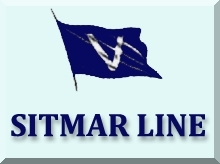
Part
One
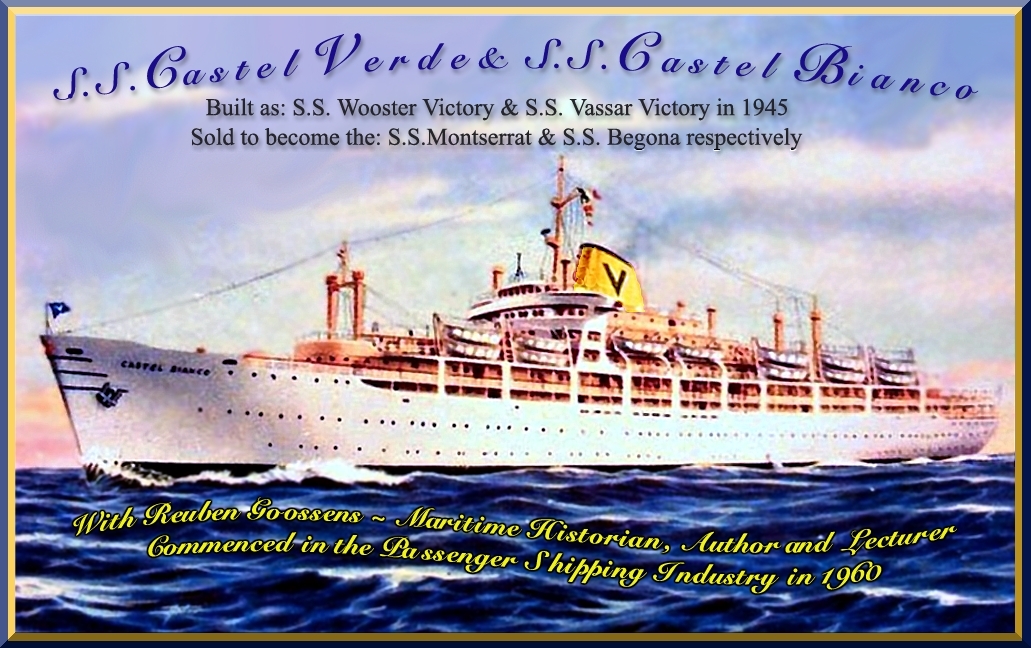
Introduction
to “The Sitmar Ships”:
Over the years I
have received unbelievable numbers of requests to add a feature on all the
Sitmar Liners and Cruise Ships. Well, it has taken a considerable time, but in
this work, I will present a short history on each ship, together with a number
of photographs. Therefore, I hope and pray that the following pages will have
you reliving your Sitmar experience or possibly experiences, be it sailing to
or from Europe/UK to New Zealand
or Australia or the America’s
on a line voyage or later as a passenger on one of their many cruises!
I certainly have enjoyed writing and compiling
this very special feature on a company that I greatly love and have sailed with
many times!
Thus now go
and read all about … The Sitmar Ships.
Reuben
Goossens.
After World War II, Alexander Vlasov who had a
long maritime history took over
Sitmar Line. Thereafter all the ships of Sitmar Line featured the large blue V
on their shapely yellow funnels. In 1949, Sitmar commenced a passenger service
between Genoa and Sydney.
SS Wooster Victory / Castel Verde:
1.
The first ship that would later become the SS Castel Verde was originally built
as one of the hundreds of “Victory VC2-S-AP2” and
“C-Class freighters,” the V Class in question being at the
“Bethlehem Fairfield Shipyards” in Baltimore, USA.
She was Hull Number 779 and had her keel laid down on February 9, 1945 and she
was launched and named the Wooster Victory on April 2, and was delivered
just twenty-three days later on April 25, 1945. Amazingly all V-Ships were
built wit an amazing efficiency and at a great speed in just or under, four
months the entire ship would be built and delivered! Yet, over the years V
Ships proved to be excellent and very reliable workhorses, as many were
obtained by various passengers companies after the war and these ships were
rebuilt into either humble migrant Liners, whilst others became more modern,
streamlined and far better looking Passenger Liners, such as Sitmar’s
delightful SS Fairsky, which had received and amazing rebuilding!
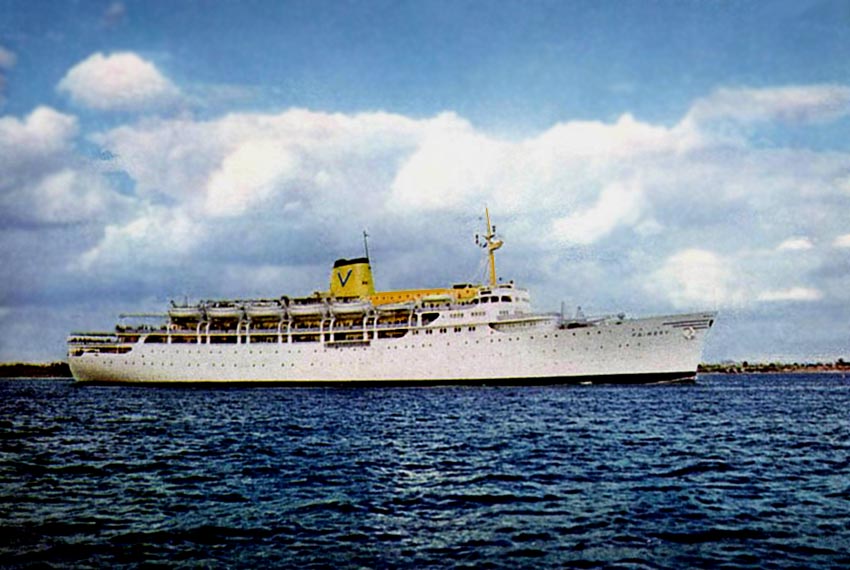
A Sitmar Line postcard of the SS Fairsky,
a ship with a similar beginning in 1941
And she served as an escort aircraft carrier during
the war, thus she was a huge rebuild in 1957
The 7,223 GRT (Gross Registered Ton) SS
Wooster Victory was handed over on “Lend Lease” terms to Great Britain and she headed across the Atlantic and there her fit-out commenced for the purpose
to become a troop transport ship. However, upon her completion and with the war
having ended, she returned to the United States,
who used her to repatriate their troops from Europe
under the management of “General Steamship Corporation” and on May
10, 1945 she was sent to the Pacific region first.
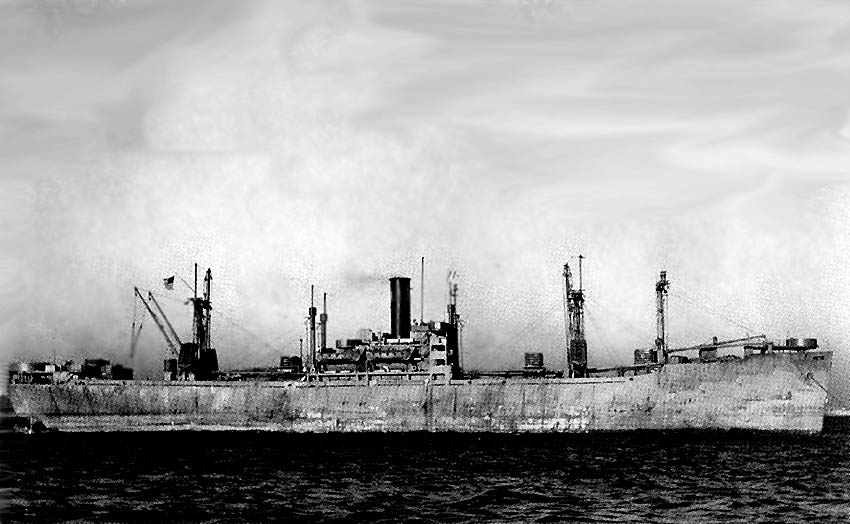
Here
we the ships in their original guise, this is the sister-ship the SS Wooster Victory in 1945
She is operating to repatriate troops from Europe as well sailing to other destinations
During this tour of duty she
actually visited Melbourne on May 25, 1945,
after which she headed via South African waters and then commenced her US
European duties making six return voyages to Europe.
On May 4, 1946 the Wooster Victory was laid
up, first at the Hampton Roads, then in the James River Baltimore having been
placed on the market!
Continued below in Part Two of the History
Section!
SS Vassar Victory / SS Castel Bianco:
2. The second
ship that would later become the SS Castel Bianco was another “Victory VC2-S-AP2
class of freighter” and she was also built by the Bethlehem Fairfield
Shipyards in Baltimore.
She was listed as “Hull 818” and her keel was laid down on March
18, 1945 and was launched and named Vassar Victory on May 4, and was
delivered twenty-four days later on May 28, 1945.
Being the identical tonnage as her sister, the
SS Vassar Victory was also handed over based on Lend Lease terms to Great
Britain and like her sister, she also was sent to England where she was fitted
out as a troop transport ship. But once again upon completion, she was also
requested to return to the United States
and operate to repatriate American troops from Europe.
SS Vassar Victory made eight return voyages between Europe and North American
ports and she returned to Baltimore
concluding her duties on April 4, 1947. She was laid up in the James River and was duly placed on the market.
Continued below in Part Two of the History
Section!
***************************
History - Part One
SS Wooster Victory 1954
to 1950 - SS Castel Verde
1950 to 1957
Later: SS Montserrat 1957 to 1973
The SS Wooster
Victory was sold to Alexandre Vlasov in January 1947 and she was
reregistered in Panama
it was decided to retain her original name. However, she remained laid up for
the time being. However, she finally left her anchorage in the James River and
headed for the shipyard at Baltimore
where classification work would be undertaken.
Refit One - From Troop Ship to a Passenger-Cargo
Liner:
However, the Wooster Victory required a general overhaul as well as a
comprehensive refit, removing her previous troop quarters and create more
comfortable dormitories for up to 890 persons with separate partitions for men
and women, including suitable and ample facilities for each. In addition a new
deck was aft of her main superstructure, which provided additional interior
space, but also extra promenade deck space as well as a sport deck above. In
addition two new lifeboats were added forward of her superstructure as well as
six more aft of the central superstructure, giving the ship a total of twelve
lifeboats, being sufficient for all on board! As a passenger ship she would
have a crew of 220.
With all work completed and having received
certification to sail, the Wooster
Victory headed for New York, but she collected cargo in several ports in
southern American ports, then on July 22, 1948 she departed from New York bound
for Genoa.
The Vlasov Group together with other companies
had signed contracts to transport displaced persons with the
“International Refugee Organisation” (IRO) to countries that were
willing to take them, which included Australia. On August 6, 1948 she
was officially transferred to Alvion S.S. Corporation.
The SS Wooster Victory departed Genoa in October 1948 being her very
first official voyage to Australia under the Vlasov (Sitmar) name and under the
auspices of the IRO who had a staff on board of an escort, a doctor and a
number of nurses to take care of the mostly Eastern European Refugees. In
November the ship arrived in Sydney
where 892 persons disembarked.
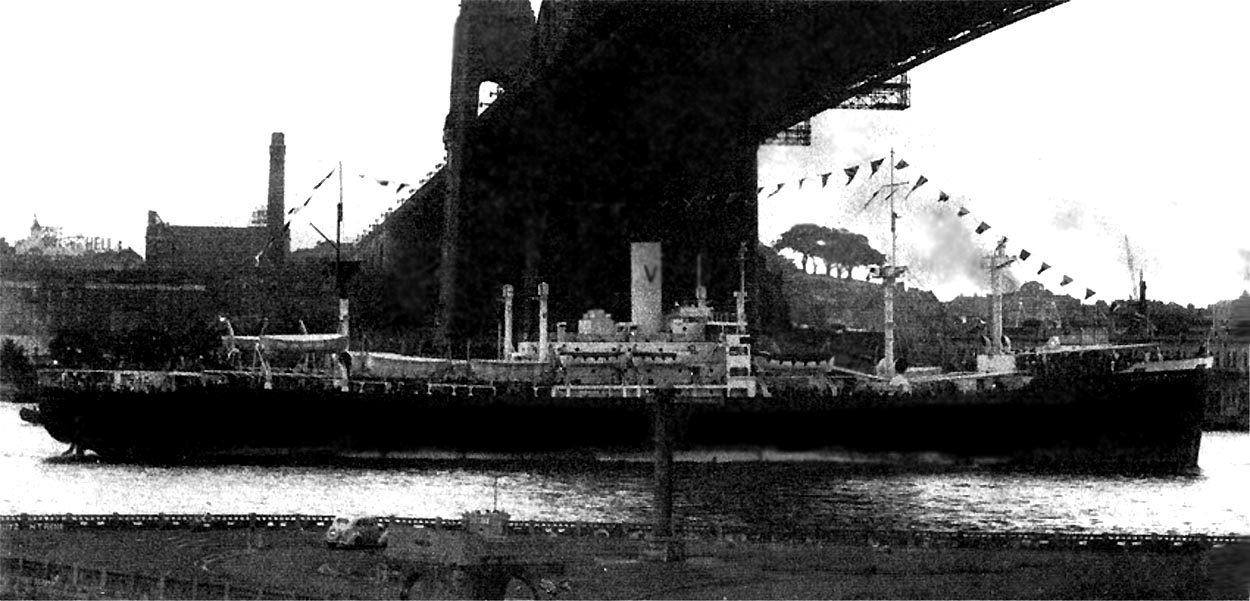
SS
Wooster Victory is seen arriving in Sydney in October 1948
She then headed for Melbourne, however upon
departure and ready for her voyage home to Italy, the ship received a radio
message to alter course from U.N.O or the “United Nations
Organization”, To sail first to Manila Philippines and there to take on
board a pilot, and await for authority to enter Shanghai where the ship is to
take on board White Russians as wells as Jewish people, escaping from Maoist
persecution. The SS Wooster Victory
departed Shanghai on Christmas Eve 1948 and a
week later her sister the SS Castel Bianco arrived at Shanghai for the same purpose. The Refugees
all disembarked at Cape Town!
At some
time in 1949 whilst the ship was in Italy, the company decided to paint
her white and thus she would fit in with the rest of the company’s
greater fleet!
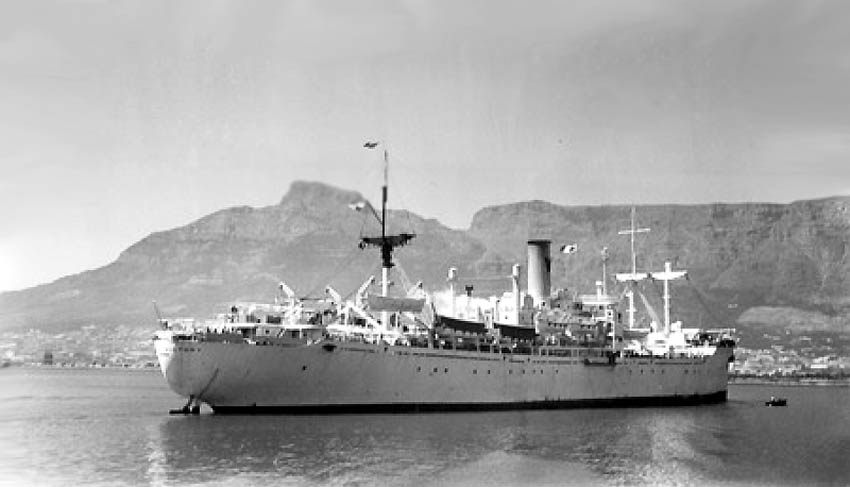
SS
Wooster Victory seen in Cape Town
1949
Refit
Two - 1950:
However, the Wooster Victory was given another
refit in Genoa,
which commenced on January 2, 1950, and during this refit she was given two
full deck of portholes in her hull providing new cabins and superior and
smaller dormitories. She now accommodated 24 passengers in cabins and 890
emigrants in dormitories, and a crew of 260. Her facilities were upgraded with
a new spacious Social Lounge and a new specious Dining Room, Her exteriors also
had a minor alteration, being painted all white, with her new shorter, shapely
but thicker yellow funnel featuring the famed Vlasov “V” logo. Her
lifeboats and masts all remained as they were fitted in 1948. In addition as
the Name Castle Verde had become available, she was officially given this name!
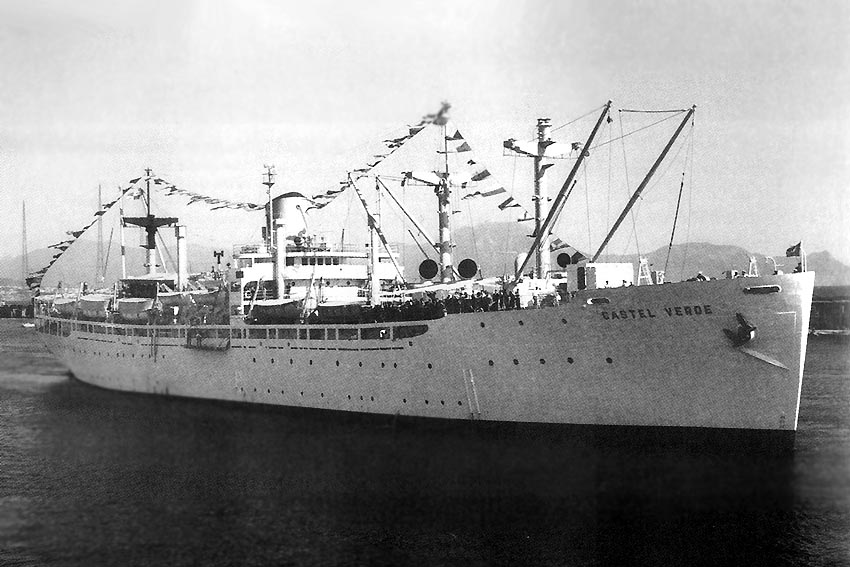
The
just completed SS Castel Verde departs Naples on
May 24, 1950 bound for Buenos Aires
Upon completion, the updated SS Castel Verde
returned to service with 914 passengers on board all bound for Buenos
Aires being her new service and she departed Genoa
on May 22, 1950 and she called in at Naples
on May 22. However, it was now decided to change her official registration and
ownership, and she was transferred from Alvion to the Sitmar Line and she was
now registered in Rome,
flying the Italian flag! Best Replica Watches
Refit Three - 1953 a Major Rebuilding Programme:
She operated her South American service for a
total of four years, however during this time she had operated a number of
sailing to Australia.
However, having returned to Italy from South America she headed to the Muggiano
Shipyards at La Spezia on April 1953 where she would receive her largest of all
her refits and on June 2 she would head for Genoa looking like a new ship with
far superior facilities for 455 in Tourist Class being accommodated in
comfortable cabins, and 578 in 32 superior dormitories, her crew increased to
275. However, her public facilities were greatly improved with more lounges and
other facilities as found on most passenger liners; in addition her
superstructure had greatly enlarged, providing more deck space for her
passengers! She was now registered as being 9,006 GRT.
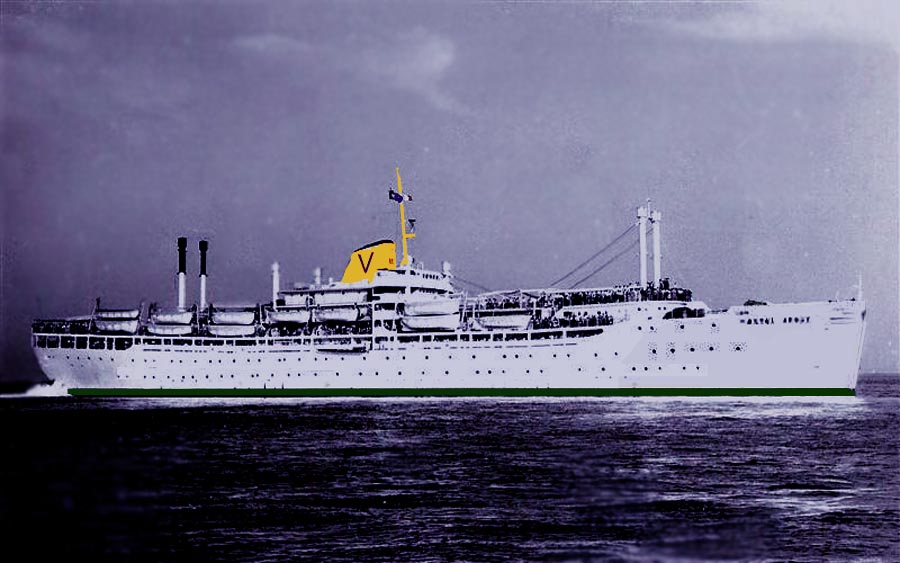
Here
we what looks like an almost new ship as the Castle Verde heads for Australia Audemars Piguet Replica
A year earlier, her sister the Castel Bianco
received much the same rebuild and refit, yet the Castel Verde was one deck
lower than the sister when she was finished, apart from this they looked very
much similar.
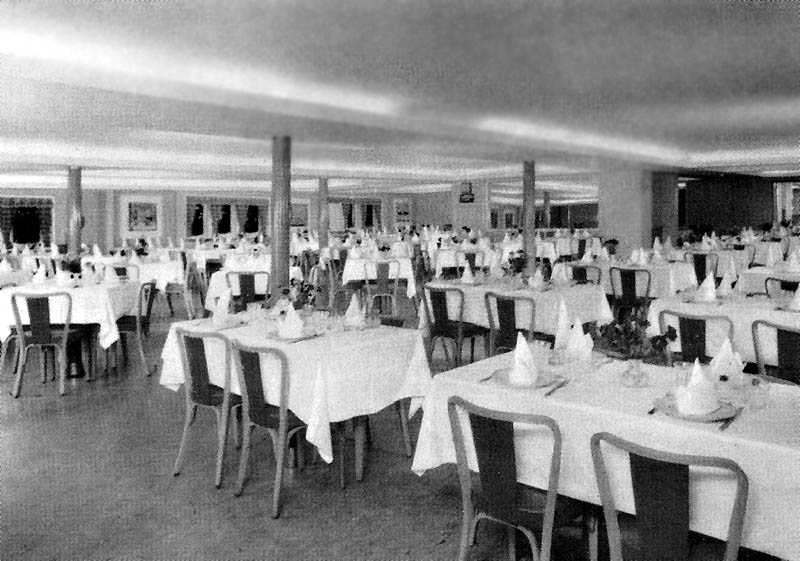
The
Main Dinning Room
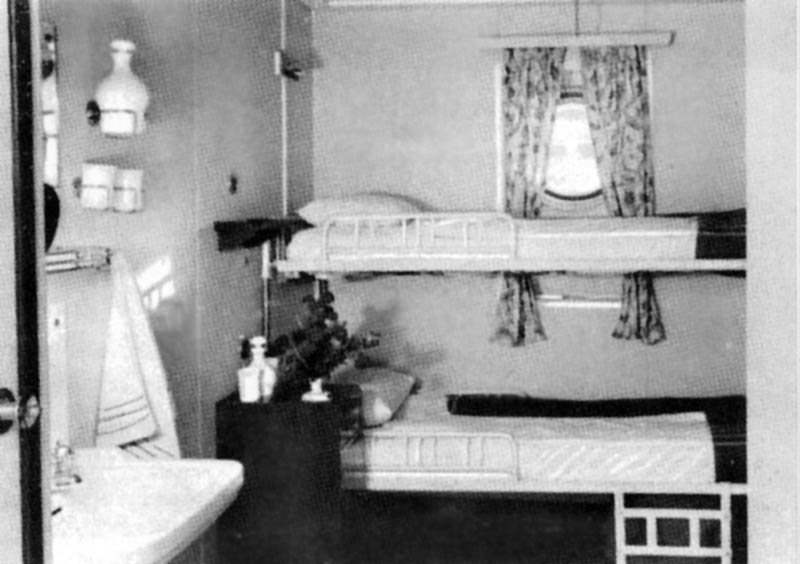
Here
we see one of the comfortable two-berth outside cabins
As soon as the Castle Verde was completed
she returned to the Central American service, but in 1954, however, she did
operate four voyages to Australia,
these being 1, July 1953, 2; April, 3; June and 4; October 1954 the latter
being her very last visit to Australia
ever! Thereafter she was mostly used on a new line service between Italy and the Caribbean; sailing from Genoa via Vigo,
Lisbon, Madeira, Tenerife to Willemstad
in Curacao. On her return she would also stop
at Kingston to
embark Jamaicans.
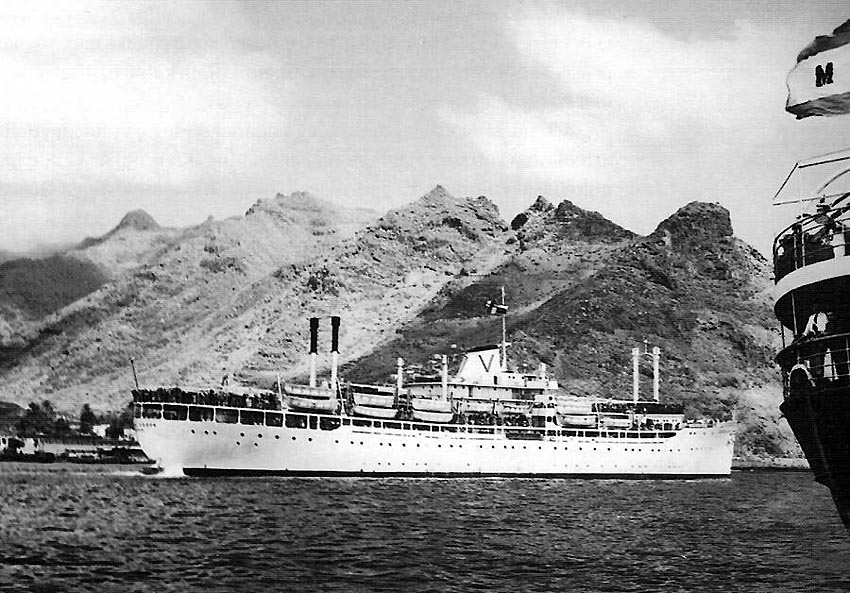
Seen the
Castel Verde after she had her 1953 rebuild
As the SS Castel Verde arrived in her Homeport
of Genoa late on March 28, 1957 the Captain and the ships crew of around 202,
were aware that this had been their final voyage on their ship many had been on
board for a considerable time, and the Wooster Victory / Castel Verde had
become like a second home to them.
However, Sitmar had now sold her as they felt
it was time to let their other fleet members Sitmar had decided to dispose of
her and her sister for that matter considering Sitmar was still operating three
ships on the Australian service, with occasional Trans-Atlantic voyages, etc.
These ships were the: SS Castel Felice
1952–70, MS Fairsea (1) 1949-1969 and the SS Fairsky (2) 1957-1977.
The Castel Verde was laid up and was sold in
April 1957 to The Spanish Line.
SS Montserrat:
“Compania Transatlantica Espanola S.A,” or “The Spanish Line” purchased the
SS Castel Verde and renamed her “Montserrat.” She
was given an extensive refit at Barcelona
vastly improving her interiors with her public facilities being redecorated,
making her far more attractive as a cruise ship. Cabins offered were from two,
three, four and some six-berth cabins, either with a porthole or inside. There
were some with private facilities, but others had shared facilities. Her
passenger capacity was vastly reduced to just 708 passengers and when
completed, she commenced service as a British based cruise ship in Southampton in August 1958.
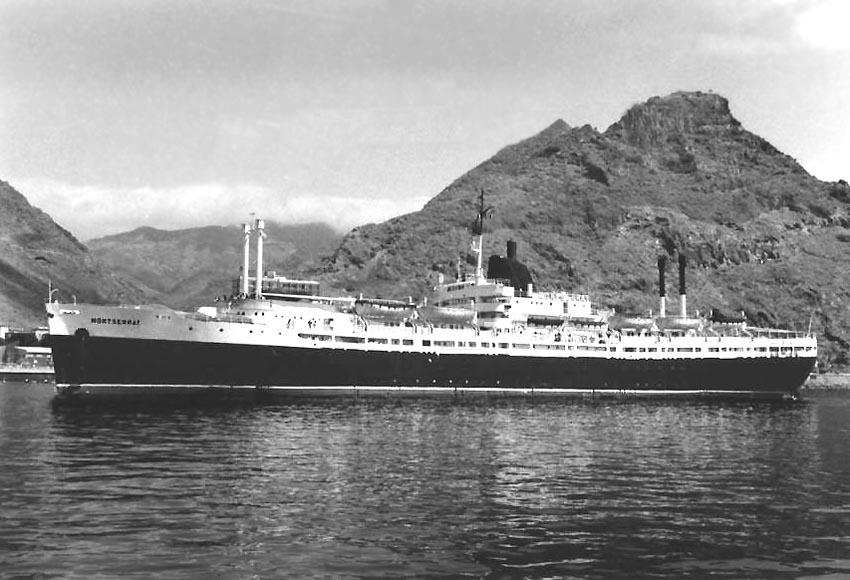
The
Montserrat is seen here
The SS Montserrat operated the following
service: Southampton, (Santander) Corunna, Vigo, Las
Palmas, Tenerife, La Guaira, Trinidad,
Barbados, (St Kitts)
Tenerife, and Vigo
back to Southampton. However, at times she
would omit Southampton and commence or conclude the cruise in Spain.
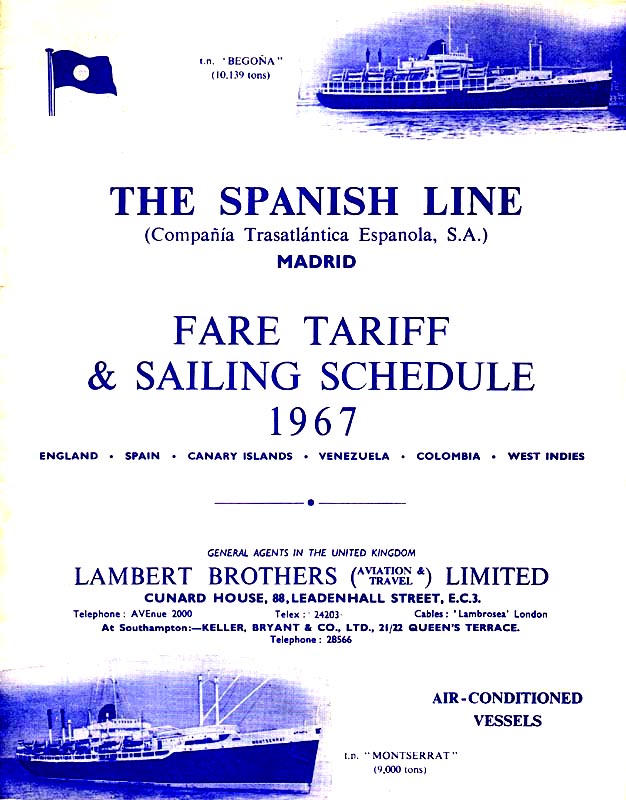
Here
we see a 1967 Fare and sailing schedule for the Two Spanish Line ships
However, the SS Montserrat did make a single
voyage to Australia.
She departed Naples
on May 6, 1959 but early into her voyage she started to suffer boiler problems,
which grew worse and worse to the point that the ship was forced to reduce
speed. By the time she reached Colombo
she had to remain there for two full weeks to make urgent repairs. She departed
and headed for Fremantle (Perth) Western Australia
arriving on June 29. Inspectors came on board and her lifeboats failed safety
inspections and the authorities refused to give the ship permission to proceed
any further until she was fully compliant! Her passengers were forced to
disembark and had to find their own way to their destinations. When the ship
was finally compliant to sail, the Montserrat was permitted to depart on July
8, 1959 and she returned to Spain.
Having returned, further repairs were made and once she was in a far better
state, she continued on the Venezuela
service until August 11, 1970 with 660 persons on board the ship suffered a
major break down, leaving her adrift mid Atlantic.
Thankfully the SS Begona happened to be close and she rushed to her rescue and
took on board all of Montserrat’s passengers, which meant she now had a
total of 1,530 persons on board, considering food supplies, the Begona headed
for port, thus leaving the Montserrat adrift for the next four days when a tug
finally was able to reach her and take her in tow and to port where repairs were
made. She returned to service for several more years, however in February 1973
she was sold to Spanish ship breakers and was scrapped at Castellon Spain that
year.
Specifications:
Built:?????????????????????????? 1945
Bethlehem-Fairfield, Baltimore,
USA.
Hull No:?????????????????????? 779.
Tonnage:???????????????????? 8,254 GRT
(1947).
.???????????????????????????????? 9,006
GRT (1954).
Length:??????????????????????? 138,7m.
Beam:???????????????????????? 18,9m.
Draught:????????????????????? 10,49m.
.???????????????????????????????? 1 H.P. & L.P. DR geared turbines
6,600 SHP.
Propeller:???????????????????? Single.
Speed:???????????????????????? 15 knots.
Operator:???????????????????? Alvion
S.S. Corporation (1947 - 1950).
.???????????????????????????????? Sitmar
Line, Genoa
(1950 - 1957.
.???????????????????????????????? The
Spanish Line 1957 - 1973).
Speed:???????????????????????? 15 knots.
Passengers:????????????????? 890 (1947 - 1950).
.???????????????????????????????? 914
(1950 - 1953).
.???????????????????????????????? 1,033
(1953 - 1957).
Other Names:……………..….Wooster Victory (1945 - 1953).
.???????????????????????????????? Spanish Line, Montserrat (1957-73).
Passengers:????????????????? 708 One Class (No cargo).
Broken Up:?????????????????? Spain 1973.
***************************
History - Part Two
SS Vassar Victory 1954
to 1947 - SS Castel Bianco 1947 to 1957
Later: SS Begona 1957 to 1975
SS Castelbianco:
The
SS Vassar Victory was the sold to Vlasov’s “Compannia
Argentina Navegacion de Ultramar” and she was reregistered to Panama. She
departed Boston and headed for the Adriatic port of Ancona, arriving on July 19, 1947. The day after her
arrival she was renamed “Castlebianco” and her registration was
transferred to the Italian flag and her funnel was painted yellow with that
famed big blue V being the “Vlasov”
logo. At first she was used as a simple cargo ship.
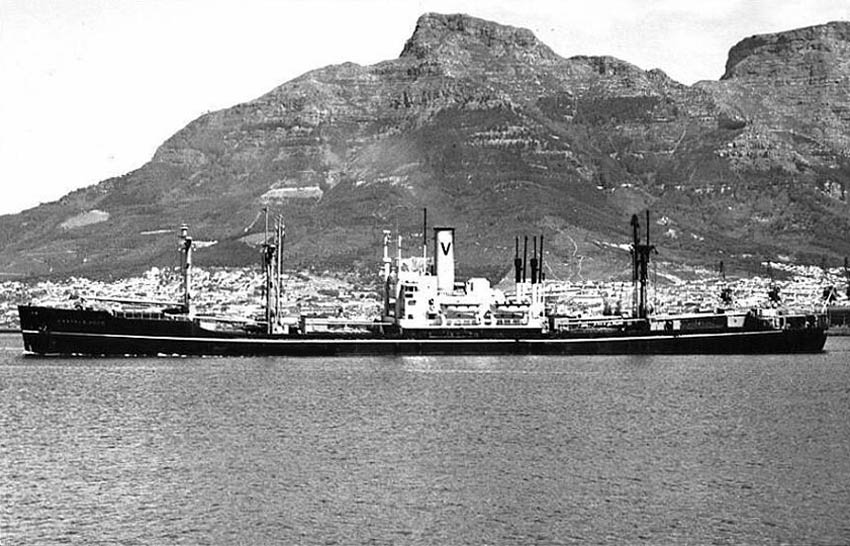
The
SS Castlebianco is seen here at Cape
Town in 1948 with her original black hull
The cargo
ship, SS Castlebianco departed Ancona on August 16, 1947 for an around the
world voyage, which became to say the least a horrific voyage! Amazingly she
was collided twice with two other freighters, in addition she was grounded at
one stage and heading for Sydney
she was caught in a severe storm damaging her badly. She finally arrived in Sydney on April 23, 1948
and remained there for a two months in order to make the necessary repairs.
Whilst at the Sydney’s
Shipyard’s, the Australian’s were able to give her a partial
interior refit in order to install some humble accommodations for 480
passengers.
It would not be until October 14, 1948
that the Castlebianco
arrived for the very first time in Genoa,
Italy with a crew complement
of forty-four. Again, with the company having signed a contract with the IRO,
the Castlebianco had taken on board a full complement of refugees and made
ready to depart, which she did on October 19, 1948 and she headed for Sydney, Australia, where she arrived on November 19.
Castlebianco, as did the SS Wooster Victory, was called to head for Shanghai where she was filled to capacity with Russian
Jews who were fleeing persecution in China.
SS Castlebianco
continued voyages from Genoa via Naples sailing via the Suez Canal, Melbourne
and Sydney, with emergency voyages to the East Indies (Indonesia) to collect
Dutch citizens who were suffering persecution, after the nation had proclaimed
its independence, and thus they and Indonesian’s who preferred to depart
also would sail to Amsterdam or Rotterdam The ship operated on this service
until April 19, 1950, for thereafter Bremerhaven would become her homeport for
the Australian service!
First Major Refit in 1950:
The Castlebianco arrived in Genoa
from Bremerhaven after returning from a voyage
to Australia
on July 13, 1950 and she was placed at the Calata Sanita Fit-Out berth where she would undergo a radical
transformation to become a passenger Liner.
She was fitted steerage accommodations for
1,132 passengers with a crew of 122Whilst the deckhouse aft of her smokestack
was enlarged where a new Social Lounge was fitted, whilst other public
facilities were located elsewhere. In addition her hull was painted white and a
full row of portholes were added in her hull. Besides her original four
lifeboats an additions eighteen lifeboats were added, six located forward of
her main superstructure and twelve aft making a total of twenty-two lifeboats.
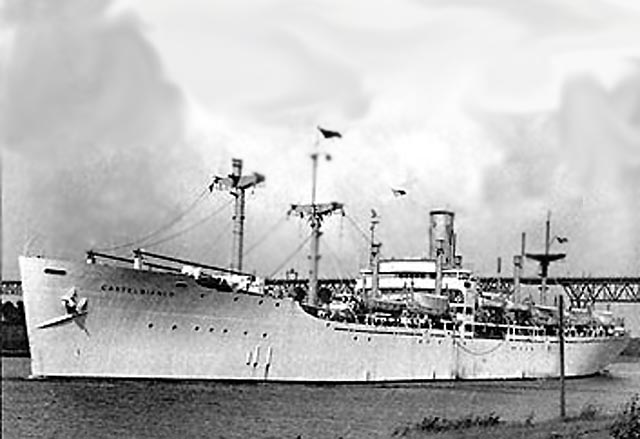
She is
seen after her first major rebuild in 1950
Once
completed, the SS Castlebianco
headed for Bremerhaven
and on September 4, 1950 she departed for Sydney and she remained on the Australian
service in accordance with the IRO schedule.
However,
soon she would undergo another refit that would the largest transformation take
place!
Second Major Rebuild & Refit in 1952/53:
This was one of the largest refits undertaken
and much was learned, for the Castle Verde’s refit was undertaken a year
later.
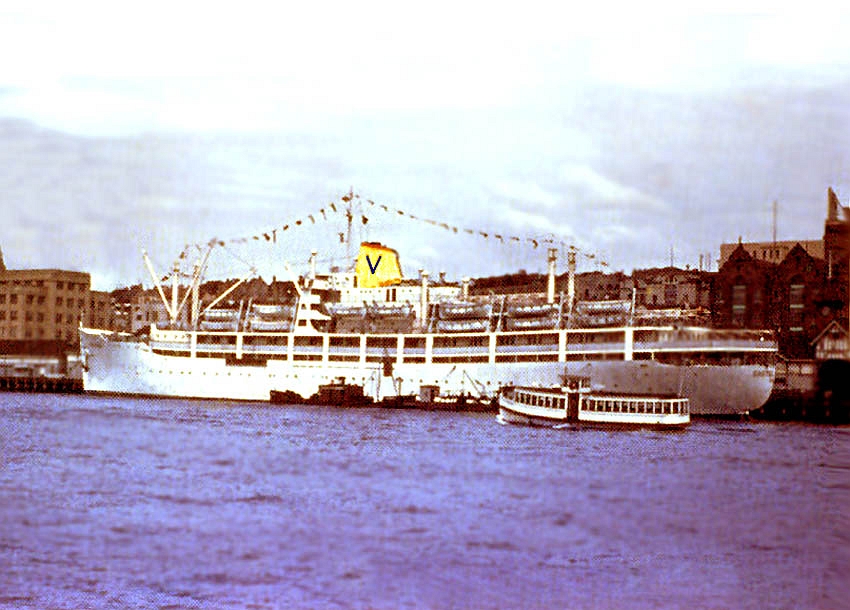
SS
Castle Bianco seen in Sydney
after her major refit in 1952/53
As SS Castlebianco had offloaded her passengers
from Australia service on
August 30, 1952, the very next day she arrived at Monfalcone Italy and the
Cantieri Riuniti Dell’Adriatico Shipyards where she would undergo her
very last major and most extensive rebuilding programme of her entire career! Topside
there would be a new two deck superstructure, Boat and Sun Decks, surmounted by
a central House, Added. The masts and cargo booms had been removed and the
raised Bridge was given a new mast. A new Upper Shelter Deck or Saloon Deck was
constructed in front of the original superstructure, thus extending the decks.
In addition even more portholes were opened up in the hull allowing more new
cabins to be fitted; as there were 111 with a porthole and 175 inside cabins.
The dormitories were now reduced in size, as they were now either with 20 beds,
or 42 beds. Total Accommodations was; 477 passengers in cabins, and 717
emigrants in dormitories.
B Deck: This
being the lower deck is where the dormitories were located and these were
segregated and all had their own facilities close by.
A Deck & Promenade Deck: This is where we find the vast majority of cabins for the full
fare paying passengers, 56 cabins having private facilities.
Saloon Deck:
contained the two Dining Rooms, the Reading
and Writing Room, the Ladies Room, as well as the Children’s Facilities
and deck space, but outside this deck was encircled by the Promenade!
Boat Deck: had
eight cabins forward, but aft of these was the Ballroom, Lounge with a Bar and
aft a Lido Deck with an open Swimming Pool.
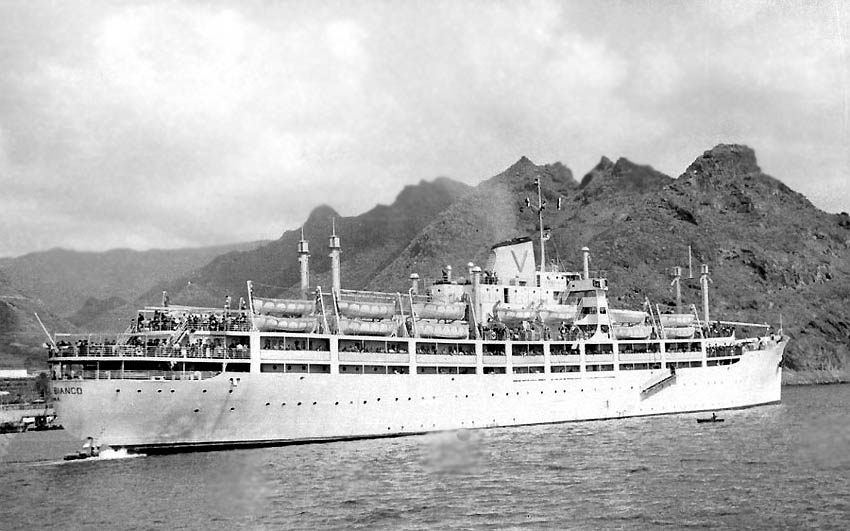
Castel
Bianco seen
in the mid 50’s
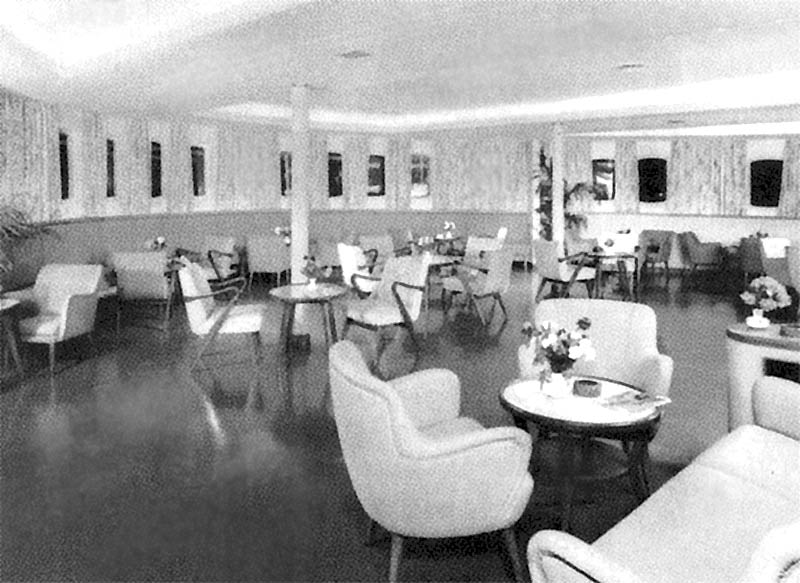
Her
main Lounge & her interiors had that typical Italian flare
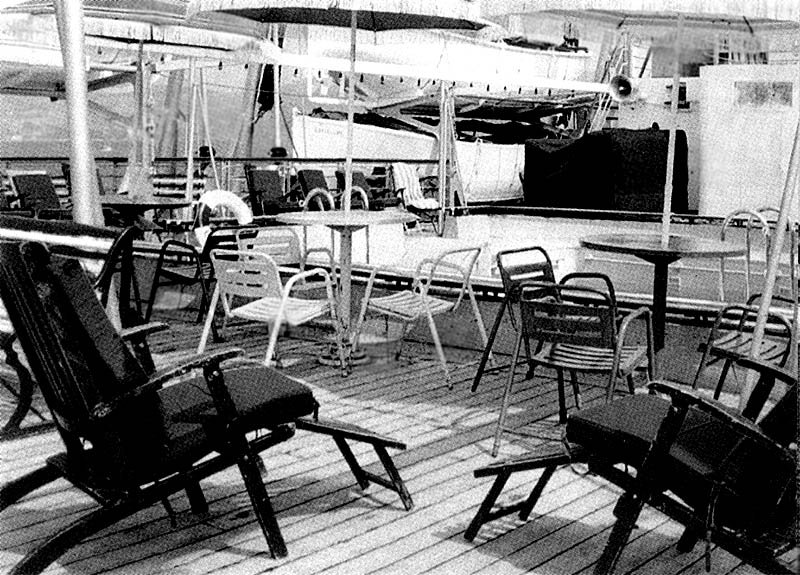
There
was a pleasant Lido Deck and Swimming Pool
Upon completion her name was officially
altered to Castel Bianco and she departed Monfalcone and arrived in Genoa late on March 3, 1953 after her
six-month massive overhaul and she looked superb. Many said that this ship was
just no longer recognisable from what she was, and there is no doubt about the
huge changes made to the old Victory ship! Although there was just one problem,
she was simply top heavy and thus the Castel Bianco became known as one of the
“Worst of all the Sitmar rollers” for she would roll even in smooth
seas! Thus it was no wonder when they rebuilt her sister ship in 1953, they did
not build her up as high!
She departed Genoa
on March 7, 1953, but she inaugurated a new service for Sitmar sailing from Genoa via the Canary Islands to Willemstad
in Curacao and La Guaira
in Venezuela
and return. She was very successful and soon the company’s flagship SS
Castel Felice joined became her running mate! Although during this time she did
make several sailings to Canada
with Hungarian migrants in the autumn of 1953. She continued the South American
service until she was transferred to the Italy
to New York
service.
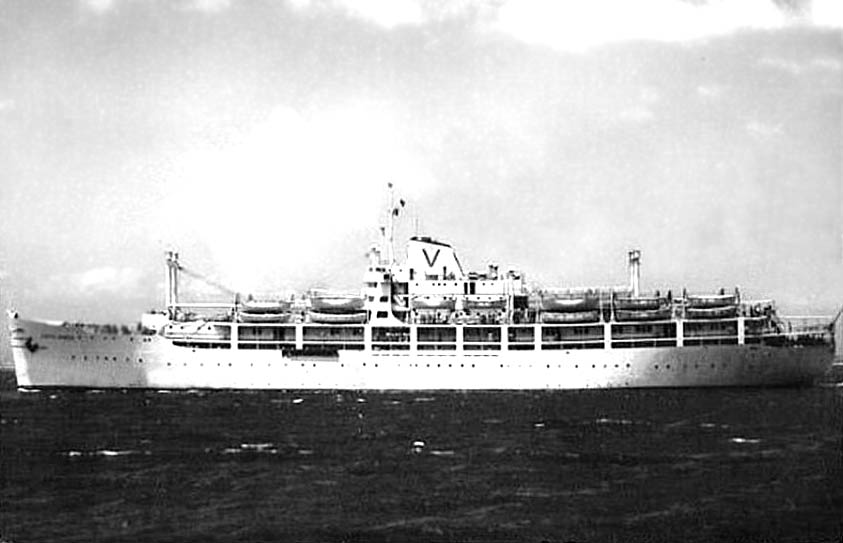
SS Castel Bianco seen
heading for Sydney
November 1956
In 1956 the SS Castel Verde made her
very visit to Australia Australian sailed into Sydney Harbour on Thursday
November 15, 1956 although unlike other final visits no one was aware, thus no
crowds to see her arrive, except for family members dockside and the same for
those returning to Europe.
Although, the Castel Bianco was the last of
these two remarkable ships to visit Australia
under the Sitmar Line banner, for her sister the Castle Verde made her last
call to Sydney
in 1954. Yet both ships would return to Australia in their next guises!
Considering the slowing down of the South
American trade and the age of these ships, Sitmar decided to dispose of the
Castel Bianco as well as her sister for Sitmar was still operating three fine
ships the SS Castel Felice, MS Fairsea (1) and the SS Fairsky the new flagship
on the Australian service, with occasional Trans-Atlantic voyages to New York
and/or Canada.
Thus the SS Castel Bianco was laid up on
February 17, 1957 and placed on the market. However within weeks a Spanish
buyer came to inspect the ship and decided that she would be perfect for The
Spanish Line as Cruise ships!
SS Begona:
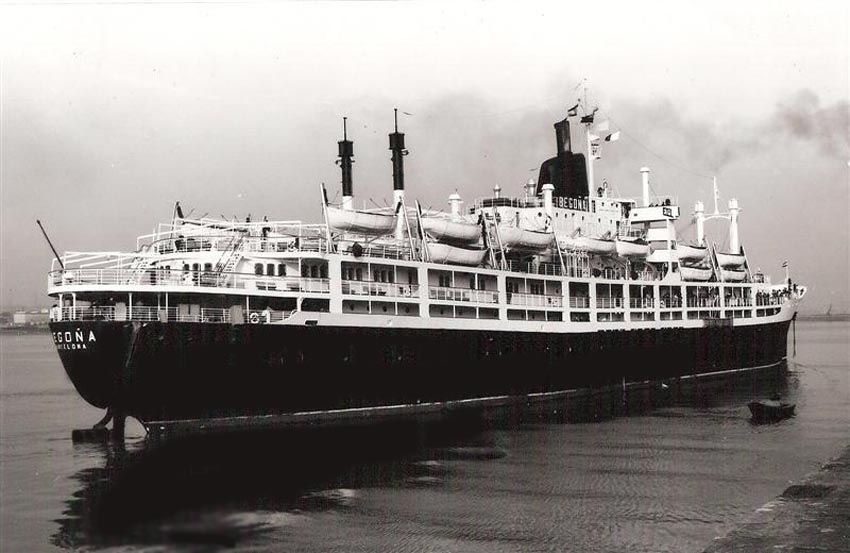
The Spanish Line Cruise Ship SS Begona
Thus, SS
Castel Bianco was officially sold to “The Spanish Line” on March
17, 1957 who renamed her “Begona” and she departed for Barcelona where she would
receive refit of not only improving her public facilities, but also deleting
all dormitories and construction new and superior cabins thus reducing her
passenger capacity 830 accommodated in comfortable
cabins. It would be a month later that The Spanish Line would also obtain the
Castel Verde and convert her.
In May 1957 the refit on the SS
Begona had been completed and her inaugural voyages under the Spanish flag
voyage would take her as far as Sydney Australia where she arrived on June 20,
and she returned to Europe on July 19, 1957.
After her Australian voyage she operated on
the Canary Islands, Caribbean and Venezuela
service based mostly in Southampton, with occasional voyages commencing and
ending in Spain.
Tragically, October 4, 1974 she suffered a
massive engine failure and she drifted for a several days, until the German tug
“Oceanic” took her in tow to Bridgetown,
Barbados. There she remained
laid up there and it was considered that it was not worthwhile repairing her
and thus she would be sold for scrap. She finally departed the next year for
Castellon in Spain
where she was broken up in 1975.
Specifications:
Built:?????????????????????????? 1945
Bethlehem-Fairfield, Baltimore,
USA.
Hull No:?????????????????????? 818.
Tonnage:???????????????????? 7,223 GRT
(1947).
.???????????????????????????????? 10,139
GRT (1954).
Length:??????????????????????? 138,7m.
Beam:???????????????????????? 18,9m.
Draught:????????????????????? 10,49m.
.???????????????????????????????? 1 H.P. & L.P. DR geared turbines
6,600 SHP.
Propeller:???????????????????? Single.
Speed:???????????????????????? 17 knots.
Operator:???????????????????? Sitmar
Line (1947 - 1957).
..??????????????????????????????? The Spanish
Line 1957 - 1973).
Speed:???????????????????????? 17 knots.
Passengers:????????????????? 480 (1947 - 1950).
.???????????????????????????????? 1,132
(1950 - 1953).
.???????????????????????????????? 1,194
(1953 - 1957).
Names:??????????????????????? Vassar Victory (1945).
Sold
to become: ?????????? Begona (1957-73).
Passengers:????????????????? 830 One Class (No cargo).
Broken Up:……………………Castellon, Spain 1975.
Also Read:………….………..The
Karlsson family sail to Canada on the Castel Bianco.
Or
Return to:………………..The Sitmar Ships - INDEX.
“Blue
Water Liners sailing to the distant shores.
I watched them come, I watched them go and I watched them die.”
****************************
Return to the
ssMaritime
Main INDEX
Where
you will discover around 690 Classic Passenger & Passenger-Cargo Liners!
ssMaritime.com & ssMaritime.net
Where
the ships of the past make history & the 1914 built MV Doulos Story
Please
Note: ssmaritime and associated
sites are 100% non-commercial and the author seeks no funding or favours of any
shape or form, never have and never will!
Photographs on ssmaritime and associate pages are by the
author or from the author’s private collection. In addition there are
some images that have been provided by Shipping Companies and private
photographers or collectors. Credit is given to all contributors. However,
there are some photographs provided to me without details regarding the
photographer/owner concerned. I hereby invite if owners of these images would
be so kind to make them-selves known to me (my email address may be found on www.ssmaritime.com only), in order that due credit may be
given.
This
notice covers all pages,
although, and I have done my best to ensure that all photographs are duly
credited and that this notice is displaced on each page, that is, when a page
is updated!
ssMaritime
is owned & ? Copyright by Reuben Goossens - All Rights Reserved





















